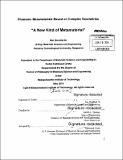Phononic metamaterials based on complex geometries : "a new kind of metamaterial"
Author(s)
Ni, Sisi (Sisi Sophie)
DownloadFull printable version (63.13Mb)
Alternative title
Design phononic metamaterials based on complex geometry
Other Contributors
Massachusetts Institute of Technology. Department of Materials Science and Engineering.
Advisor
Edwin L. Thomas.
Terms of use
Metadata
Show full item recordAbstract
Facing the growing challenges of energy, environment, security and disease treatment, the demand for novel materials are growing. While the material centric approach have resulted in development of new materials for advanced applications, we introduce a geometric approach as a complementary point of view for further innovation in this ever expanding and growing field. Inspired by the ubiquitous fractals-like geometry of in natures, the scale transformation (i.e. dilation or contraction) is included in the framework since fractal geometries shows structures at all scales (usually discrete and finite in physical world). We developed our framework using metamaterials since it enable us to design "atoms" or "molecules" and their relative arrangement with greater freedom (i.e. not limited by the chemical bond or ionic bond in classical materials system). We studied metamaterials using prefractals from both exact-self similar fractal and random fractal samples. For exact-self similar fractals, we choose H tree based prefractals and Hilbert Curve prefractals bounded system given their unique geometric properties and wide applications. Guided by the framework, we investigated several key parameters (e.g. level of iteration, geometric anisotropy, impedance contrast, arrangement of subunit, resolution) that would dictate the dispersion behavior of the system. It was found that for exact-self similar prefractals, multiple spectrum bandgaps (i.e. broadband response) can be achieved with increased level of iterations where translation symmetry is imposed through boundary condition. Furthermore, the transition from scale dependence and independent described by the general framework has been observed for all the samples we studied. Furthermore, for single prefractal resonator, subwavelength (~1/75[lambda]) behavior has been observed and explained using a simple analytical model. For metamaterials based on fractional Brownian motion, the Hurst constant is found to be a good indicator of phononic behavior of the system, besides other parameters studied. Our findings does not only expand the repertoire for novel materials by introducing the ubiquitous yet unconventional geometry to metamaterials; but also have interdisciplinary applications in biology, seismology, arts, hence shine lights on our understanding of nature.
Description
Thesis: Ph. D., Massachusetts Institute of Technology, Department of Materials Science and Engineering, 2014. Cataloged from PDF version of thesis. Includes bibliographical references.
Date issued
2014Department
Massachusetts Institute of Technology. Department of Materials Science and EngineeringPublisher
Massachusetts Institute of Technology
Keywords
Materials Science and Engineering.